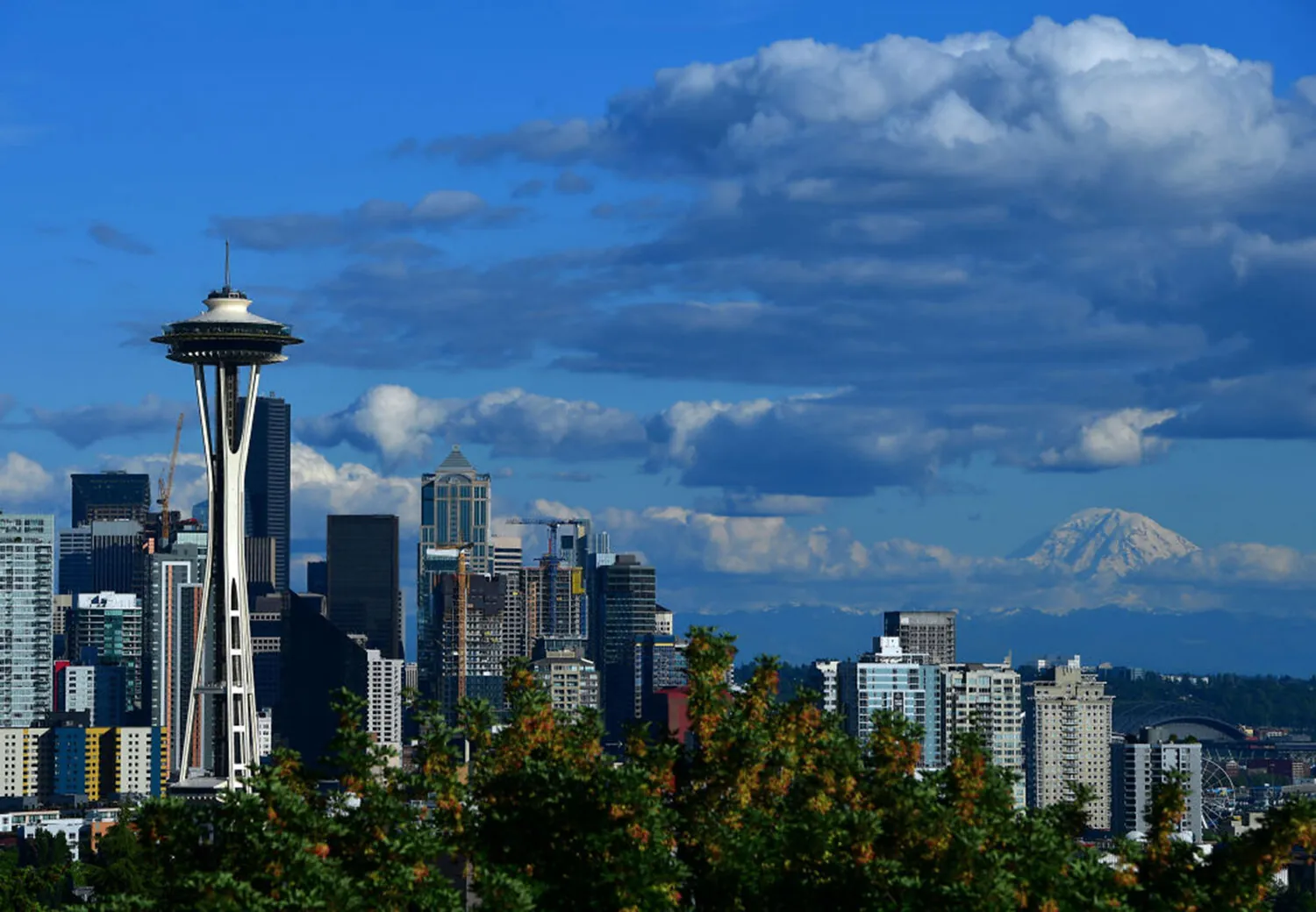A recent study reveals yet another potential seismic threat to the Puget Sound region. Already facing a variety of daunting earthquake scenarios, including the Cascadia Subduction Zone and shallow faults beneath major cities, this area may now also be susceptible to a one-two punch of earthquakes.
By utilizing advanced techniques in tree ring and radiocarbon dating, experts have determined that the last significant earthquake on the Seattle Fault was not an isolated incident. In fact, the Saddle Mountain Fault, which runs through the Olympic Peninsula near Lake Cushman, also experienced a rupture around the same period.
With remarkable accuracy, the team managed to pinpoint the exact date within a six-month window, between the autumn of 923 A.D. and the subsequent spring, which was approximately 1,100 years ago.
The outcomes of their research were made public on Wednesday through the publication of their findings in the Science Advances journal.
According to Harold Tobin, the director of the Pacific Northwest Seismic Network at the University of Washington, the project was a remarkable achievement in the field of seismology. The extensive five-year project involved divers equipped with underwater chain saws to extract samples from trees that were submerged by the earthquakes. To accurately determine the date of these events, the team utilized a novel method that identifies signs of ancient solar storms that are preserved in the tree rings.
According to Tobin, the recent findings have introduced a new, worst-case scenario for the seismic threats faced by the 4 million individuals residing in the region. As per the study, a double whammy seismic event could be significantly more destructive than a single earthquake, especially for older buildings made of brick and concrete, as well as vulnerable bridges and infrastructure. This scenario has not yet been taken into account in hazard maps, building codes, or emergency planning. Tobin suggests that it is crucial to consider this possibility and incorporate it into future planning efforts.
According to Tobin, the probability of this event occurring in any given year is not significant. Therefore, there is no need to panic because of this study. However, it emphasizes the importance of being adequately prepared for such situations.
According to a 2005 analysis, even a moderate magnitude 6.7 earthquake on the Seattle Fault could have catastrophic consequences, resulting in the loss of 1,600 lives, the destruction of almost 10,000 buildings, and economic losses of up to $50 billion. However, a new study suggests that the potential damage could be even more severe if the Seattle and Saddle Mountain faults were to rupture simultaneously. In this scenario, the resulting earthquake would be significantly stronger, with a magnitude of 7.8 — almost 40 times more powerful — and would impact a much larger area.
According to Morgan Page, a co-author of the study from the U.S. Geological Survey, the precise order of the historical earthquakes is still uncertain.
After analyzing earthquake sequences around the world, the researcher concludes that there is a 3-to-1 chance that the faults ruptured at the same time. However, it is also plausible that the two earthquakes occurred at different times, with a gap of several hours, days, or even months. If that is the case, the study suggests that their magnitudes range from 7.3 to 7.5.
According to John Cassidy, a senior seismologist at Natural Resources Canada, clustered earthquakes were previously classified as aftershocks and believed to have occurred on the same fault. However, recent studies have revealed that a slip on one fault can result in stress on other faults. This was evident in the Turkey earthquake in February, where the initial earthquake caused a powerful rupture on an adjacent fault nine hours later, resulting in widespread destruction.
When earthquakes occur near urban areas, the effects can be particularly severe due to the shallow depth of the quake. This can result in much more intense shaking than what was experienced during the last major earthquake in Washington, the magnitude 6.8 Nisqually event in 2001, which originated over 20 miles beneath the surface.
Tobin stated that if an earthquake were to occur on the Seattle Fault, the consequences would be far more severe than any other earthquake.
Thankfully, shallow fault quakes are a rare occurrence in Washington. According to researchers, the seismic activity that took place between 923-924 A.D. was the most intense episode since the end of the last ice age, which was approximately 16,000 years ago. While geologists do not have extensive records of most faults in the area, it appears that most of them experience some activity every thousand to several thousand years. Tobin stated that the USGS estimates a 5% chance of a significant earthquake occurring along the Seattle Fault within the next 50 years.
According to Tobin, the recent earthquake that hit Morocco happened in a region where such occurrences are infrequent. In fact, it was the most intense earthquake ever recorded in the area, making it an unprecedented event.
The latest study is based on findings from over three decades of geological research. During the early 1990s, researchers conducted fieldwork that revealed various indicators of the Seattle Fault earthquake. This event caused significant uplift of the Alki Point and southeastern tip of Bainbridge Island, with a maximum uplift of up to 20 feet. The quake also generated a tsunami that affected the West Point Treatment Plant site. Furthermore, landslides occurred on Mercer Island, causing old-growth forests to slide into Lake Washington. Even today, some of these trees remain standing upright in nearly 300 feet of water.
After the Saddle Mountain earthquake, the ground was shattered by a massive scarp that towered 24 feet high. This blocked a drainage and gave rise to Price Lake, which caused the drowning of trees as the water level continued to rise.
The research was based on the well-preserved trees that were submerged in oxygen-deprived cold water. These trees were found in Lake Washington, Price Lake and other locations, and played a crucial role in the study.
According to previous radiocarbon analysis, the Seattle Fault quake has been dated to occur between 900 and 930 A.D. However, there are interesting indications from other faults, such as Saddle Mountain, Olympia and Tacoma, that suggest they might have also ruptured during that period. Nevertheless, traditional methods have only provided possible age ranges that extend over several centuries for those other sites.
According to Brian Sherrod, a USGS scientist who has dedicated his career to studying faults in the state, the level of uncertainty was too high.
During a scientific conference, Sherrod had a fortuitous meeting with Bryan Black, a renowned dendrochronologist from the University of Arizona. This encounter marked the beginning of a long and exciting journey that lasted several years.
Sherrod explained that solving the puzzle was a lengthy process due to its complexity. In his opinion, the real story lies in the innovative techniques introduced by Bryan and his team.
According to Black, tree rings have the potential to provide more accurate dating compared to radiocarbon. However, in order for this to work, the samples must be in excellent condition, including the presence of bark and extensive ring sequences. This means that only select samples can be used for this method of dating.
Collecting cores and wood slices from numerous researchers was one of the most challenging tasks. However, Black managed to gather useful samples from 47 Douglas firs at six locations where the trees were submerged by the earthquakes. These samples captured almost 300 years of history, making them incredibly valuable for the research.
As part of their research, the team needed to gather fresh samples from Price Lake. Even though the stumps of the Douglas firs that were killed during the earthquake were still visible, obtaining usable samples was not an easy task for the USGS divers. The murky water in the lake made it difficult for them to find sections of the trees with intact bark. Lead author of the study, Black, explained that the divers would often spend up to an hour cutting a single wedge from a tree due to the extremely low visibility.
In order to accurately date the tree rings, the researcher utilized a reference sequence obtained from 1,300-year-old firs that were previously collected on Vancouver Island in the 1990s. This allowed for the precise determination of the date of the outermost ring of the tree.
According to Black, he meticulously sanded each sample several times, utilizing lapping films made of micron-level diamond grit. He went on to explain that the sanding process was so thorough that the individual cells within the wood could be seen under a microscope.
Upon aligning his samples with the reference trees, there was no denying the answer.
Through the use of radiocarbon analysis of tree rings, the date’s authenticity has been validated. This technique involves the detection of cosmic timestamps known as Miyake events, which are named after the Japanese physicist who first discovered them. These events signify bursts of radiation that result from solar flares or exploding stars that occurred centuries or even millennia ago. Fortunately, these spikes in cosmic radiation cause corresponding spikes in atmospheric carbon-14 levels, which serves as the clock that supports radiocarbon dating, making it an essential tool in dendrochronology.
Fortunately for Black and his team, a Miyake event took place in 774 A.D. which was detected in the Douglas fir samples they collected. This provided them with an accurate reference point for counting.
“Boom,” he exclaimed. “We had a breakthrough moment when we realized that all of these trees perished with the final fully-developed ring being dated back to the year 923.”
For over three decades, the question of when the Seattle Fault ruptured and whether other faults played a role has remained an enigma. Professor David Black has spent years working on this mystery, and he now understands why it has been such a complex and demanding project. In his own words, “This has been the most challenging dating project in my career.”
As for him and Sherrod, their quest is far from over. Their current mission is to locate sunken trees that may be connected to the Tacoma and Olympia faults. The goal is to determine if the earthquake that occurred over a millennium ago was more widespread than previously thought.
Seattle is currently taking action to address the threat posed by old brick buildings, commonly known as unreinforced masonry (URM), which are considered extremely perilous during an earthquake. Over 1,000 URM structures, including apartments, offices, churches, and meeting halls, are situated throughout the city, and previous attempts to mandate retrofits have repeatedly failed.
According to Amanda Hertzfeld, the URM program manager, a new rule has been introduced which aims to simplify and standardize the retrofitting requirements. The upcoming voluntary retrofit program is expected to be implemented by next spring. While the ultimate goal is to make upgrades mandatory, Hertzfeld has not specified a timeline for it yet.



